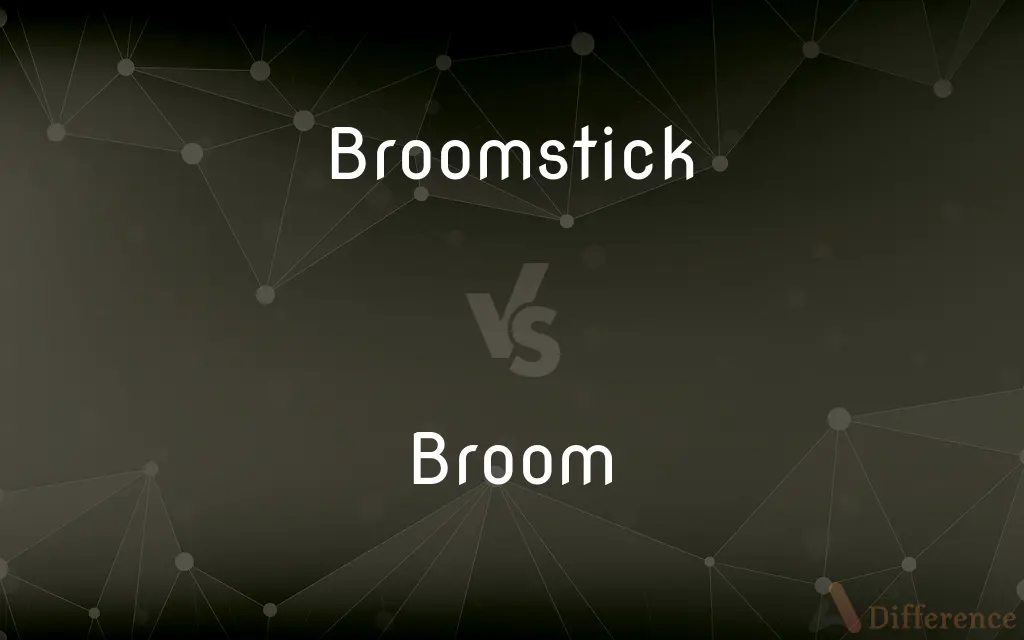Broomstick vs. Broom — What's the Difference?
Edited by Tayyaba Rehman — By Fiza Rafique — Updated on March 5, 2024
Broomstick refers specifically to the long handle of a broom, while a broom is a cleaning tool consisting of bristles attached to a handle, used for sweeping.

Difference Between Broomstick and Broom
Table of Contents
ADVERTISEMENT
Key Differences
A broomstick is the elongated handle part of a broom, traditionally made from wood but also available in various materials like plastic or metal in modern iterations. It's designed to provide leverage and reach for the user, making the sweeping process more efficient and comfortable. In contrast, a broom encompasses the entire cleaning tool, including both the handle (or broomstick) and the head, which is composed of bristles or fibers gathered together to sweep dust and debris from floors and other surfaces.
While the term "broomstick" often conjures images of witches' flights in folklore and popular culture, highlighting its symbolic presence beyond practical applications, a broom's significance lies in its utility within everyday cleaning tasks. The broomstick's role is primarily functional, serving as the backbone of the broom and enabling control and motion of the bristle head. On the other hand, the broom, as a whole, is a staple in household and commercial cleaning, valued for its effectiveness in maintaining cleanliness.
The design and construction of the broomstick are crucial for the broom's overall performance. Factors such as length, diameter, and material affect the user's comfort and the broom's durability and functionality. In contrast, the broom's effectiveness in cleaning tasks depends on the type and arrangement of its bristles or fibers, which vary according to the intended use, such as soft bristles for indoor floors and stiffer ones for outdoor surfaces.
Broomsticks have also found alternative uses beyond their traditional role in brooms, including in crafts, gardening stakes, or even as components in makeshift projects. This versatility showcases the broomstick's utility as an individual component. However, a broom's identity and utility are inherently tied to its complete form, integrating the broomstick and bristles to fulfill its primary function of sweeping.
The evolution of brooms and broomsticks reflects advancements in materials and manufacturing processes, with modern variations offering ergonomic designs and materials to enhance user comfort and cleaning efficiency. Despite these innovations, the fundamental distinction remains: the broomstick as the supportive structure and handle, and the broom as the comprehensive cleaning implement.
ADVERTISEMENT
Comparison Chart
Definition
The handle of a broom
A cleaning tool with bristles attached to a handle
Composition
Usually made of wood, plastic, or metal
Consists of a broomstick and a head with bristles or fibers
Primary Use
Provides leverage and reach for sweeping
Sweeps dust and debris from surfaces
Cultural Image
Often associated with witches in folklore
Symbolizes cleanliness and household maintenance
Versatility
Can be used in crafts and makeshift projects
Mainly used for cleaning purposes
Compare with Definitions
Broomstick
The handle part of a broom, typically elongated for leverage.
She grabbed the broomstick to reach the cobweb in the corner.
Broom
Essential for household and commercial cleaning tasks.
The janitor swept the school hallways with a large broom.
Broomstick
Made from wood, plastic, or metal for durability.
The metal broomstick was sturdy and resistant to bending.
Broom
Represents cleanliness and maintenance.
Keeping a broom by the door is seen as inviting cleanliness into the home.
Broomstick
Modern designs focus on user comfort and efficiency.
The ergonomic broomstick reduced strain during prolonged sweeping.
Broom
Varied according to use, from soft for indoors to stiff for outdoors.
The stiff-bristled broom easily cleared leaves from the sidewalk.
Broomstick
Often depicted as witches' transportation in stories.
The witch flew through the night sky on her enchanted broomstick.
Broom
A cleaning tool combining a broomstick with bristles for sweeping.
She used a soft-bristled broom to clean the hardwood floors.
Broomstick
Used in various crafts and gardening.
He used an old broomstick to support the tomato plants.
Broom
Features ergonomic handles and synthetic bristles for better performance.
The new broom's synthetic bristles efficiently collected pet hair.
Broomstick
The handle of a broom.
Broom
A broom (also known in some forms as a broomstick) is a cleaning tool consisting of usually stiff fibers (often made of materials such as plastic, hair, or corn husks) attached to, and roughly parallel to, a cylindrical handle, the broomstick. It is thus a variety of brush with a long handle.
Broomstick
The handle of a broom (sweeping tool).
Broom
An implement used for sweeping, typically consisting of a bunch of stiff synthetic fibers or broomcorn stalks, or formerly twigs or straw, bound together and attached to a handle.
Broomstick
A broom imbued with magic, enabling one to fly astride the handle.
Broom
Any of various European and North African shrubs of the genus Cytisus in the pea family, especially C. scoparius, having mostly compound leaves with three leaflets and showy, usually bright yellow flowers.
Broomstick
(intransitive) To fly on a broomstick, as witches are said to.
Broom
Any of several similar or related shrubs, especially in the genera Genista and Spartium.
Broomstick
A stick used as a handle of a broom.
Broom
Sweep with a broom or as if with a broom;
Sweep the crumbs off the table
Sweep under the bed
Common Curiosities
What are the typical materials used for broomsticks?
Broomsticks are commonly made from wood, plastic, or metal.
What is the main difference between a broomstick and a broom?
A broomstick is just the handle part of a broom, whereas a broom includes both the handle and the bristles for sweeping.
How do the bristles of a broom vary?
Broom bristles vary in stiffness and material, tailored for different cleaning surfaces and tasks.
What innovations have been made in broom design?
Modern brooms feature ergonomic handles and synthetic bristles designed for comfort and efficiency in cleaning.
Can a broomstick be used for purposes other than sweeping?
Yes, broomsticks can be repurposed for crafts, gardening supports, and various other projects.
How do cultural representations of broomsticks differ from their practical use?
Cultural representations, such as the association with witches, focus on myth and folklore, whereas practical use emphasizes the broomstick's functionality in cleaning and household maintenance.
How has the evolution of broom and broomstick design impacted household cleaning?
The evolution of broom and broomstick design, including the introduction of ergonomic features and synthetic materials, has made household cleaning more effective, easier, and less physically demanding, reflecting advancements in understanding ergonomics and material science.
What considerations should be made when choosing a broom for indoor vs. outdoor use?
When choosing a broom for indoor use, softer bristles are preferred to protect floor surfaces, while outdoor brooms benefit from stiffer bristles to handle heavier debris on rougher surfaces.
Why are ergonomic broomsticks important?
Ergonomic broomsticks are important because they reduce physical strain and enhance comfort, making sweeping more efficient and less tiring for the user.
Can the material of a broomstick affect the overall performance of a broom?
Yes, the material of a broomstick can significantly affect the broom's performance by influencing its durability, weight, and ease of use, impacting how effectively and comfortably it can be used for sweeping.
Share Your Discovery

Previous Comparison
Afternote vs. Note
Next Comparison
Twining vs. TwinningAuthor Spotlight
Written by
Fiza RafiqueFiza Rafique is a skilled content writer at AskDifference.com, where she meticulously refines and enhances written pieces. Drawing from her vast editorial expertise, Fiza ensures clarity, accuracy, and precision in every article. Passionate about language, she continually seeks to elevate the quality of content for readers worldwide.
Edited by
Tayyaba RehmanTayyaba Rehman is a distinguished writer, currently serving as a primary contributor to askdifference.com. As a researcher in semantics and etymology, Tayyaba's passion for the complexity of languages and their distinctions has found a perfect home on the platform. Tayyaba delves into the intricacies of language, distinguishing between commonly confused words and phrases, thereby providing clarity for readers worldwide.
















































